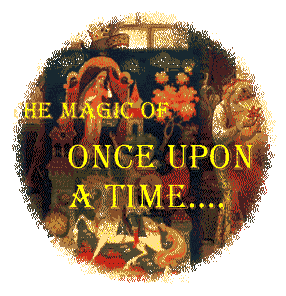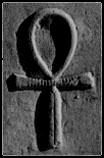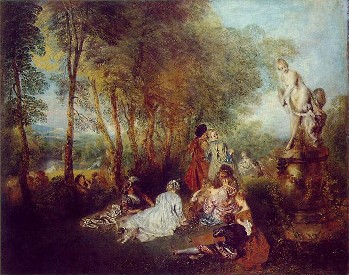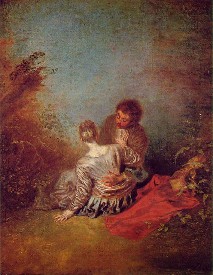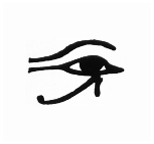|
Narrative Logo - Click for Main Menu Lecture II. Tales Told Around the Fire - The Oral Folk Tradition
Characteristics of Oral Material Tales enchant us for several reasons. They beguile us because they are always changing, because they are often told in an atmosphere of intimacy, because they are sometimes more daring and exciting than what appears in print, and because they necessarily speak to our deepest hopes and fears in a sensory, imaginative way. Most of all, they persist - a quality that carries infinite implications, in itself.
Representation of the Ankh glyph of Egyptian fame
Many of you will recognize the sign of the Ankh. It appears in the earliest Egyptian inscriptions. While this is a graphic representation, we know that a considerable oral folklore surrounded the Ankh and the concepts it symbolized. Some experts claim that the Ankh is a representation of a sandal strap. Others have claimed that it represents a loop of rope and a weight, similar to the anchor that might have been used by early reed boats on the Nile to prevent them from drifting at ANCHOR. Whatever the origin, we can see the same symbol persisting throughout in many religious contexts as a sign of eternal life. Some observers have speculated that it was the forerunner of the Christian Cross. CHANGING: However, what we do see, with this example in particular, is that one factor of change in Folklore is its spread or adaptation in another culture or application. Agents of change, then can be quite varied. A. First, we can have a story that stays in essentially the same culture and time and changes in the telling, from one tale-maker to the next.
this painting by Watteau (from Mark Hardin's archive site) illustrates the kind of environment in which we see "Beauty and the Beast" rewritten. A good example exists in the several "beauty and the beast" tales that originated in France in the late Seventeenth and early Eighteenth Centuries. A year before Perrault published "Ricky of the Tuft," Mlle. Bernard published a version which was far harder on the beautiful but dumb heroine. Later, Madame D'Aulnoy in The Ram, and a short time later, in the "Beauty and the Beast" title, itself, carried the story to further moral realms. There were two "beauties," published in 1740 and 1756 by Mme. de Villeneuve and Mme. Beaumont. (These versions are discussed by Zipes in Fairy Tales and the Art of Subversion, pp. 30-41).
The Beast (a man) appealing to a reluctant Beauty B. Second, we can identify tales which change over time. Cinderella is again a good example, as we can trace that tale in quite fixed versions in our own culture. At the same time that the Disney books and videos are still in circulation, we have a re-telling of this tale in popular film under the title Pretty Woman. The setting is now Rodeo Drive, the Cinder-girl is a woman of questionable virtue, and the Prince is a local rake. But this IS a Cinderella tale.
Julia Roberts as a Fantasy Bride C. Third, we can identify stories that are altered by movements between cultures. Cinderella is, again, a good example. We have already talked about the way in which the Perrault story darkens considerably (to having the eyes of the two Ugly Sisters plucked out) in Northern European versions. But another good example is The Little Mermaid. Most of us believe that we are familiar with the original literary tale by Hans Christian Anderson (which is a re-telling of a common water-nymph folk tale). However, even before Disney turned this into a success tale, American writers were reluctant to punish the Little Mermaid with the full power of Anderson's judgment. The Anderson version begins like this: "Far out at sea the waterīs as blue as the petals of the
loveliest cornflower, and as
clear as the purest glass; but itīs very deep, deeper than any anchor can reach. And it ends with the line: “After three hundred years, thus shall we float into the kingdom of heaven,” said she. “And we may even get there sooner,” whispered one of her companions. “Unseen we can enter the houses of men, where there are children, and for every day on which we find a good child, who is the joy of his parents and deserves their love, our time of probation is shortened. The child does not know, when we fly through the room, that we smile with joy at his good conduct, for we can count one year less of our three hundred years. But when we see a naughty or a wicked child, we shed tears of sorrow, and for every tear a day is added to our time of trial!”
the Little Mermaid of Copenhagen Harbor The Disney synopsis reads like this:
Graphic of cover of The Little Mermaid video from Disney Americans, of course, are relentlessly optimistic, and our culture shapes its versions of fairy tales to comply with our expectations about life.
D. And, we can find stories or ideas that actually change their meanings, become demonized, even, as they move across the globe or through time. To return to an Egyptian example, the Eye of Horus, so sacred to the Egyptians, becomes, in European medieval lore, the Evil Eye.
The Wejat Eye INTIMATE DARING IMAGINATIVE PERSISTENT
|
